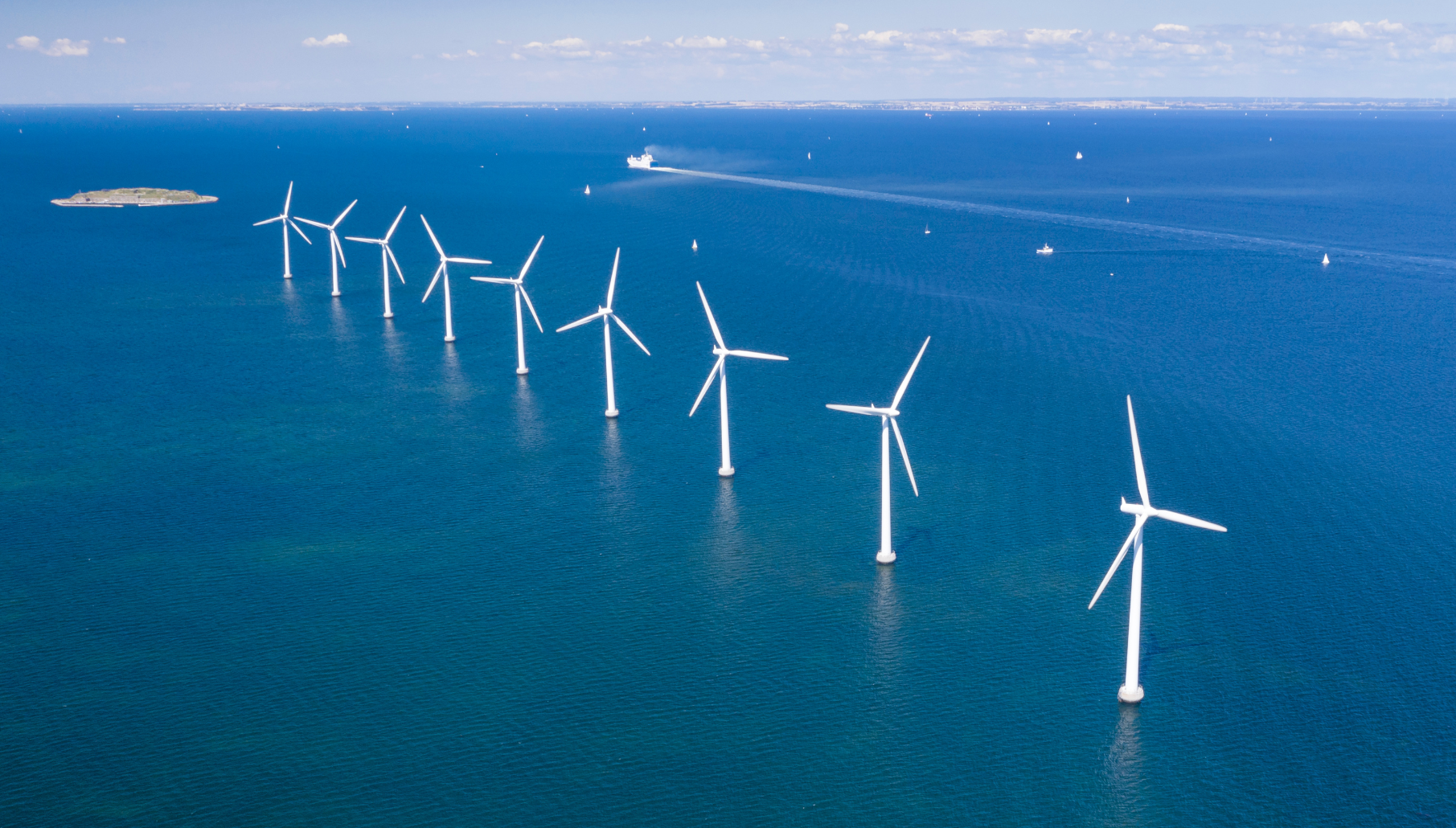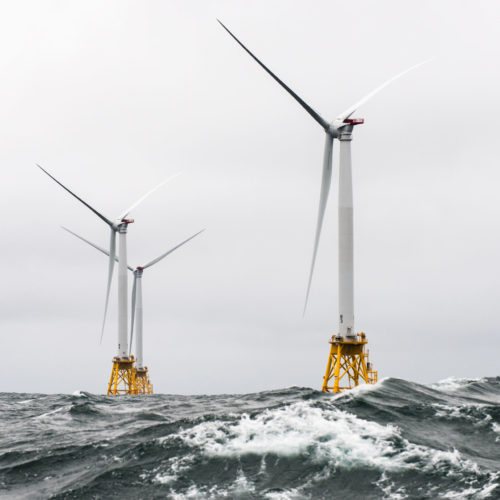As offshore wind advances, experts urge regional collaboration on transmission planning
This article appeared in the 2022-23 edition of Perspectives.

Credit: Canva
In federal waters off the coast of Massachusetts, Vineyard Wind is erecting 62 massive turbines, each as tall as the Eiffel Tower. Sometime next year, the turbines will start sending electricity into the New England grid — enough to power 400,000 homes.
The project is the first in a wave of commercial-scale wind farms slated to come online in the next few years, driven largely by competitive state policies and economic incentives to attract investments in ports, manufacturing, training, staging, and assembly.
Yet as states vie for industry leadership, analysts are urging collaboration to overcome a key challenge to scaling the sector: finding the most efficient way to bring the electricity to shore. Experts say that cooperation is essential to lowering costs and speeding the integration of large amounts of ocean-based power.
During the 2022 Annual Meeting, New Jersey Board of Public Utilities Commissioner Bob Gordon likened the magnitude of the coordination challenge to the creation of the interstate highway system during the Eisenhower era.
“My message for my colleagues in other states is this: Start thinking about ways we can collaborate in the planning process for developing offshore transmission,” Gordon told the CSG East Energy and Environment Committee during a briefing with industry representatives. “I think it would be a great benefit if states could start working together.”
Although currently there are only two small offshore wind pilots in the United States — in waters near Rhode Island and Virginia — some 30 gigawatts are on track for development by 2030 along the East Coast, enough to power roughly 20 million homes.
A need for a shared approach
So far, transmission has been built on a project-by-project basis, using a “generator lead-line” approach, in which developers build an individual cable for each wind farm, connecting them one by one to the onshore high-voltage network. This go-it-alone approach is driven by state solicitations that bundle generation and transmission, as well as federal regulations, which allow radial lines to be included with each lease. In addition, early projects have sought to establish certainty by controlling their own grid interconnections.
Nevertheless, experience from the European Union — where countries have been developing offshore wind since 1991 — revealed that over time, this individualized approach led to costly grid upgrades and complicated permitting challenges. A promising alternative is to create a planned system enabling transmission developers to build an independent grid to connect multiple wind farms, said Peter Shattuck, president of Anbaric New England.
“Independent transmission infrastructure can serve as a platform for third parties. Think Amazon,” Shattuck told CSG East members during the August briefing.
He explained that through economies of scale, a planned system lowers costs for both onshore and offshore transmission. There are several designs being considered, including a high-capacity transmission backbone and a hub-and-spoke model, in which several wind turbines are connected by a single high-capacity cable, notes a report from the think tank Urban Ocean Lab. These designs are also intended to reduce environmental impacts and alleviate local siting conflicts by limiting the number of grid connection points along the coastline.
Shattuck cited an industry study for the United Kingdom, which has had significant offshore development using the generator lead-line approach. The analysis, conducted by the Brattle Group consulting firm, found that if development moved to a planned approach by 2030, it could cut the cost of transmission almost in half.
Additional studies estimated that a planned grid connecting multiple wind farms off the coast of New York state would lower transmission costs by $500 million and reduce environmental impacts and project risk. These studies also showed that New England taxpayers could save $1.1 billion compared with the cost of independently linking nearby offshore wind farms to an onshore network.
In recent months, those states have taken steps to enable collaborative approaches.
New York’s third solicitation for offshore wind, announced in July, requires that any project using high-voltage direct current cables must be “meshed-ready” so that it can plug into a broader ocean-based transmission network, if one is built. The solicitation seeks to procure at least 2 gigawatts of offshore wind, enough to power 1.5 million homes, as part of an overall target of at least 9 gigawatts by 2035.
New Jersey’s plan
New Jersey regulators are pursuing their own planned approach with regional grid operator PJM, Inc., and the results have been impressive, said Shattuck.
Last year, PJM held a competitive solicitation of managed transmission projects to achieve the state’s then-goal of developing and integrating 7.5 gigawatts of offshore wind into the grid by 2035. (In September, Governor Phil Murphy raised the target to 11 gigawatts by 2040, the most ambitious goal of any state.) The state received 80 bids from 13 developers — including Anbaric — to cost-effectively deliver power from offshore development to customers. In October, the state selected the winning bid: the Larrabee Tri-Collector Solution 1, a proposal jointly submitted by Mid-Atlantic Offshore Development and Jersey Central Power & Light. Officials said the project will cost the average residential customer $1.03 per month.
New Jersey is authorized to engage in a competitive planning process to achieve its offshore wind targets by the Federal Energy Regulatory Commission’s Order 1000, a rule that enables one or more states to propose a project to help achieve public policy objectives with the costs passed through to ratepayers.
“This is groundbreaking,” said Gordon. “New Jersey is working with PJM to integrate our policy goals to bring offshore wind into the grid. We are the first state in PJM to take this on.”
So far, other states in the PJM region that are developing wind farms have not announced plans to pursue a planned approach. But at least two of those states — Maryland and Pennsylvania — have joined a new federal partnership with the Biden administration and 11 East Coast governors that aims to coordinate the buildout of the offshore wind supply chain and address regional transmission and interconnection, among other issues.
Creating a supply chain infrastructure
Some grid experts have warned that failure to address the transmission challenge could slow the progress of the projects that are moving forward and the pace of jobs being created in manufacturing, shipping, testing facilities, and other key infrastructure.
A recent federal study estimates that the offshore wind industry will need an average of up to 58,000 full-time jobs every year from 2024 to 2030, compared with fewer than 1,000 jobs today.
States are partnering with industry, academic, environmental justice, and community groups to create technical training and university degree programs. In Massachusetts, Vineyard Wind has invested $2 million to support an industry workforce, including curriculum development in local schools and training certification programs with community colleges.
“We’re working hard to connect local vendors with the offshore wind industry, to get locals trained,” said Christian Scorzoni, the company’s director of government affairs, during the August briefing.
Recently, Massachusetts and four other New England states announced an initiative to explore pathways for optimizing clean energy transmission infrastructure. In September, the states asked for public feedback on a draft conceptual framework for integrating offshore wind into the New England grid and on how best to position states and the region to access federal funds. The Inflation Reduction Act allocates $100 million for offshore wind transmission planning, modeling, and analysis.
The request for information notes that the offshore wind projects currently under contact will use up all of the available transmission capacity at the most convenient and cost-effective connection points in Rhode Island and Cape Cod. Any future development connected under the current, project-by-project approach will trigger potentially billions in upgrades to the onshore grid — investments that could be avoided through a planned, regional approach, it says.
During a virtual scoping meeting in October, the New England group learned about a U.S. Department of Energy study that is exploring coordinated transmission options to maximize Atlantic Coast offshore wind development. Greg Brinkman, a researcher at the National Renewable Energy Laboratory who is involved in the study, said that linking different offshore wind platforms to enable transmission expansion between regions could enhance reliability and resiliency and mitigate grid congestion. But planning ahead is critical.
“There’s kind of a time aspect to it all,” he said. “If we are putting out a lot of transmission in the offshore space that is not any sort of future-proof design, that can’t be interlinked, it will be more and more challenging as time passes to be able to realize any of those potential benefits,” he said.
The agency estimates that a well-planned offshore grid could facilitate up to 110 gigawatts of offshore wind by midcentury. It plans to release its transmission study at the end of 2023.

